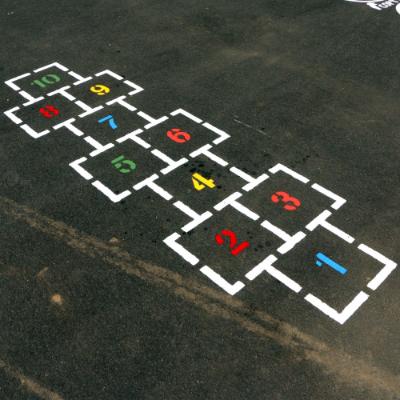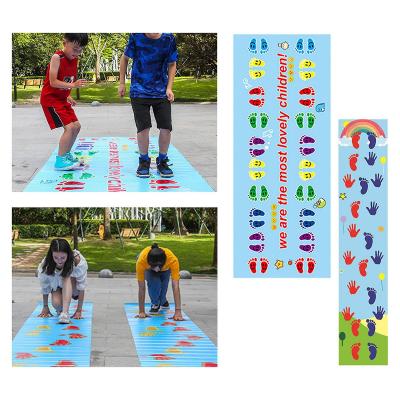Hopscotch boasts ancient roots, dating back to Roman times. Initially a military training exercise, it evolved into a popular children’s game across cultures.
The game’s appeal lies in its simplicity and adaptability. Throughout history, hopscotch has entertained kids and reflected cultural values, fostering social skills and physical activity. Today, it remains a cherished global pastime, highlighting the universal joy of playful movement and the importance of preserving traditional activities for generations to come.
| We have lots more for your holidays and your free time to make fun and interesting. Physical activities are important for children’s growth. So we come with a variety of Indoor Obstacle Games Ideas, and Whiteboard Games. |
What Is The Pattern For Hopscotch?
Hopscotch typically follows a simple and recognizable pattern, often played on a flat surface like pavement or concrete. Here’s an essential guide to the traditional hopscotch pattern:
Single Grid
- Draw a single, continuous grid on the ground, usually with chalk.
- It consists of a series of numbered squares arranged linearly, typically 1 to 9.
Starting Line
- Participants stand behind the starting line, often marked at one end of the grid.
Marker Toss
- Like a small stone or beanbag, a marker is tossed into the first square.
Hop Sequence
- The player hops through the grid, starting with square 1 and progressing to the highest number.
- Players land on one foot for squares with a single number; for squares with two numbers, they land with one foot in each square.
Single-Leg Balance
- Upon reaching the end, the player turns and hops back, picking up the marker.
End of Turn
- Each turn is completed successfully if the marker is picked up without any mistakes.
Next Player
- Players repeat the sequence, with the difficulty increasing as more players complete the pattern.
How Many Numbers Are On Hopscotch?
Traditionally, a standard hopscotch grid consists of nine numbered squares. The squares are arranged in a linear pattern, often drawn on a flat surface such as pavement or concrete. Players hop through these squares in a specific sequence, starting from square one and progressing to the highest number. The sequence may include hopping with one foot or two, depending on the design of each square. While variations exist, the classic hopscotch game usually features this simple yet engaging structure with nine numbered squares.
Hopscotch Game Rules
Hopscotch rules can vary, and players often adapt them based on personal preferences or regional traditions.
Setup
- Draw a hopscotch grid on a flat surface with numbered squares (usually 1 to 9).
- Place the marker (a small stone or beanbag) at the starting line.
Player Rotation
- Players take turns, and the order is established before the game begins.
Marker Toss
- The first player tosses the marker into square 1 without letting it touch the lines.
Hop Sequence
- The player hops through the grid, starting from square 1.
- Land on one foot in single-numbered squares and use two feet for double-numbered squares.
Single-Leg Balance
- At the end, turn around and hop back, picking up the marker along the way.
- Maintain balance on one foot when bending down to pick up the marker.
Avoiding Lines and Missing Squares
- Players must hop over the square containing the marker.
- If a player steps on a line, misses a square, or loses balance, their turn ends.
Passing the Marker
- Successfully completing a turn allows the player to pass the marker to the next square on the grid.
Next Player’s Turn
- The next player follows the same sequence, with the marker advancing to the next square with each successful turn.
Winning
- The first player to complete the entire sequence (1 to 9) wins the game.
- If a player makes an error, their turn is forfeited, and play continues with the next player.
Variations
- Players can create variations with different hop patterns, challenges, or modified rules for added fun.
Hopscotch Game How To Play Step-By-Step Guide

Here is the guide to playing hopscotch with joy.
Materials Needed
- Flat surface (pavement or concrete)
- Chalk or tape for drawing the grid
- Small marker (stone, beanbag, etc.)
Setup
Draw the Grid
- Use chalk or tape to draw a hopscotch grid on the ground. The grid typically consists of single and double-numbered squares, arranged in a linear pattern.
Number the Squares
- Number the squares from 1 to 9. You can customize the design, but the standard hopscotch grid has nine squares.
Place the Marker
- Position the marker at the starting line, usually at one end of the grid.
Gameplay
Player Order
- Decide the order of players. The youngest player often goes first.
Toss the Marker
- The first player tosses the marker into Square 1 without it touching the lines or bouncing out of the square.
Hop Through the Grid
- Hop through the grid, starting from Square 1.
- Use one foot for single-numbered squares and both feet for double-numbered squares.
- Skip the square containing the marker.
Single-Leg Balance
- At the end of the grid, turn around and hop back, picking up the marker without touching the ground.
- Maintain balance on one foot while retrieving the marker.
Passing the Marker
- If the turn is successful, the player advances to the next square, tossing the marker into that square.
Errors and Turn Forfeiture
- If a player steps on a line, misses a square, or loses balance, their turn ends.
- The next player then takes their turn.
Winning
- The first player to successfully complete the sequence from Square 1 to 9 wins the game.
Variations
- Players can create variations by adding challenges, changing hop patterns, or inventing new rules to keep the game interesting.
Now you’re ready to enjoy the classic and timeless game of hopscotch!
Hopscotch Game For Preschoolers’ Ideas – Fun and Educational Numbered Shapes
Instead of numbers use shapes in the hopscotch grid. Preschoolers can learn about circles, squares, triangles, and more as they hop through the different shapes.
Colorful Hopscotch
Assign each square a different color. Children can practice recognizing and naming colors as they hop from one colorful square to another.
Alphabet Hopscotch
Label each square with a letter of the alphabet. Preschoolers can practice saying the alphabet while hopping through the grid.
Animal Sounds Hopscotch
Draw pictures of animals in each square and write the corresponding animal sound. Children can mimic the sounds as they hop, combining physical activity with auditory learning.
Gross Motor Skills Challenge
Create a hopscotch grid with various challenges in each square, such as hopping on one foot, jumping backward, or twirling around. This enhances gross motor skills development.
Storytelling Hopscotch
Assign each square a different story element (character, setting, action). As preschoolers hop through, encourage them to create a simple story based on the elements they land on.
Counting Fun
Number the squares, and as children hop through, they can count aloud. This is a great way to reinforce counting skills playfully.
Nature Hopscotch
Take the hopscotch game outside and draw squares with pictures of natural elements like trees, flowers, and animals. Encourage discussions about nature as they play.
Shapes and Colors Combo
Combine shape recognition with color identification. Each square can represent a different colored shape, providing a dual learning experience.
Team Hopscotch
Create a collaborative hopscotch grid where children take turns hopping and working together. This promotes teamwork and social interaction.
10 Hopscotch Game For Adults
Fitness Challenge Hopscotch
Incorporate fitness exercises into each square, such as lunges, squats, or jumping jacks. This turns hopscotch into a full-body workout for adults.
Trivia Hopscotch
Label each square with a trivia question. Adults answer the question corresponding to the square they land on, combining mental stimulation with physical activity.
Balance and Coordination Hopscotch
Increase the challenge by adding activities that enhance balance and coordination, like hopping on one foot, crossing feet, or incorporating agility movements.
Yoga Pose Hopscotch
Assign different yoga poses to each square. Adults can practice mindfulness and flexibility while hopping through the grid.
Memory Lane Hopscotch
Customize the squares with significant life events, memories, or achievements. As players hop through, they share stories associated with each memory.
Socializing Hopscotch
Create a larger grid with squares that have conversation starters or icebreaker questions. This turns hopscotch into a social activity, fostering connections among adults.
Drinking Game Hopscotch
Add a playful twist by assigning drink-related challenges to each square. For example, take a sip, toast, or invent creative drinking rules for a lighthearted adult version.
Themed Hopscotch Events
Organize hopscotch events with themes like costume hopscotch, where participants wear costumes as they play, adding a touch of whimsy and creativity.
Team Building Hopscotch
Create a collaborative hopscotch grid with squares representing team-building activities. This fosters camaraderie and teamwork among participants.
Music and Dance Hopscotch
Combine hopscotch with music and dance. Each square can represent a dance move, and players dance through the grid, making it a lively and entertaining experience.
FAQs
Why is it called hopscotch?
- In English-speaking regions, the name “hopscotch” is a fusion of “hop” and “scotch,” capturing the essence of the game’s hopping and scoring elements.
- In India, the game goes by various names such as “Kith-Kith” or “Ekka Dukka,” reflecting linguistic diversity.
- In Spain, it is known as “La Rayuela,” emphasizing the act of hopping.
- Italy has its versions, known as “Campana” or “Mora,” with variations in dialects.
- The French refer to it as “Marelle,” while in the Middle East, particularly in Arabic, it’s called “تور تور” (Tawreeq Tawreeq).
- In Urdu, hopscotch is commonly known as “لکڑیاں” (Lukkariyan).
- In Punjabi, it can be referred to as “ਸਟੇਚੂ” (Stechu) or “ਸਟੇਪੂ” (Stepu), though variations in local dialects may exist.
What is the standard number in hopscotch?
The hopscotch grid typically consists of nine numbered squares, arranged in a linear pattern.
Is hopscotch for girls?
Hopscotch is a gender-neutral game enjoyed by both boys and girls. It provides a fun and active way for children to develop physical coordination, balance, and social skills. Hopscotch transcends gender boundaries, offering enjoyment and benefits to children of any gender.
What are the benefits of number hopscotch?
Number hopscotch provides a range of benefits for children, including physical exercise, motor skills development, and math practice. It enhances social interaction, stimulates cognitive abilities, and encourages creativity.

